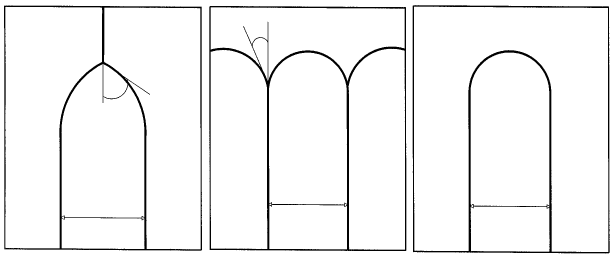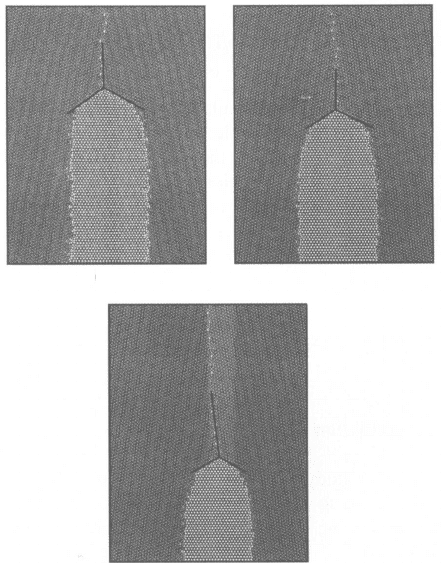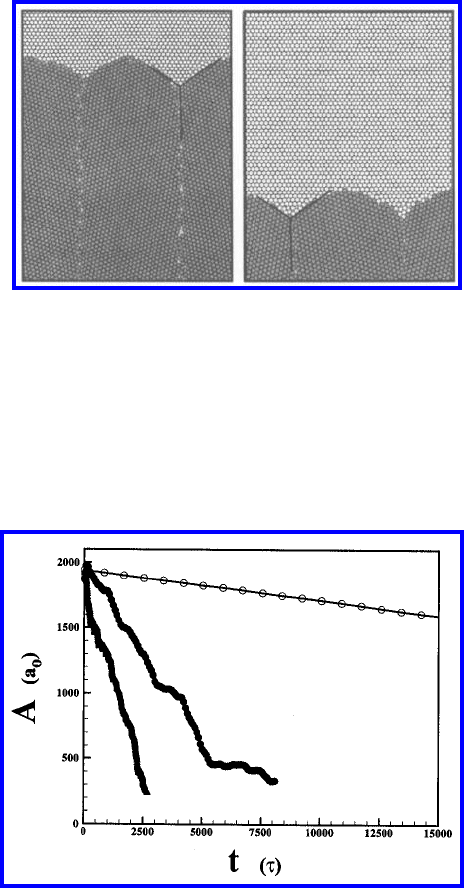Gottstein G., Shvindlerman L.S. Grain Boundary Migration in Metals: Thermodynamics, Kinetics, Applications
Подождите немного. Документ загружается.


496 5 Computer Simulation of Grain Boundary Motion
still showed some tendency to GB sliding, but its magnitude was far less than
for the Σ5 (36.9
◦
)twistGB.
(d) The final displacement field found in each (002) plane after a GB had swept
the plane was dominated by in-plane displacements that were linked to the
GB screw dislocation cores. The atoms moved in a cooperative manner. The
largest displacement vectors were in the range of a next neighbor distance or
less. Even at the highest temperatures the discrete screw dislocation network
of the low-angle twist GBs prevailed, and even when the approaching GBs
came very close, this situation did not change. This demonstrates that the
low-angle twist GBs behaved exactly like a discrete screw dislocation network
in fcc crystals. The activation enthalpies found for the low-angle twist GBs
are very low, low even compared to the [001] high-angle twist GBs studied
in this work and must be associated with the motion of the structural screw
dislocations. It also explains the drop in activation enthalpy observed in the
transition from high-angle [001] twist to low-angle twist GBs.
TABLE 5.7
Scaling Behavior of the Found GB Activation Enthalpies of the Studied [001] Twist
GBs for the LJ Potential
GB plane θ Σ Q
GBD
/Q
vac
[1] Q
GBM
/Q
GBD
[1] Q
GBM
/Q
fus
[1]
(001) 43.60
◦
29 0.519 0.428 3.4
43.60
◦
29 0.284 0.404 1.7
(001) 36.87
◦
5 0.528 0.306 2.5
36.87
◦
5 0.347 0.466 —
(001) 28.07
◦
17 0.355 0.381 2.1
(001) 22.62
◦
13 0.414 0.348 2.2
(001) 16.26
◦
25 0.226 0.776 2.7
(001) 12.68
◦
41 0.128 0.433 0.8
(001) 8.80
◦
85 0.297 0.207 0.9
(001) 6.03
◦
181 0.257 — —
Note: Here the activation enthalpy of volume self-diffusion via mono-
vacancies in an fcc system modeled by the LJ potential used in this
work with 3D periodic BC is Q
vac
=1.972 eV. Further Q
GBD
represents
the GB self-diffusion enthalpy as determined in this work for
each GB and Q
GBM
is the GB migration enthalpy. Finally Q
fus
is
the latent heat of fusion as determined in [539] and reads Q
fus
=0.13 eV.
5.8.2 Grain Boundary Diffusion of [001] Twist Boundaries
Owing to a lack of reliable data on grain boundary mobility it is frequently
assumed that GB migration and GB diffusion involve the same mechanisms so
that the activation energies are essentially identical. The computed activation
© 2010 by Taylor and Francis Group, LLC

5.9 Simulation of Triple Junction Motion 497
enthalpies of GB self-diffusion of each GB and volume self-diffusion are listed
in Table 5.7 namely, r
GBD
vac
=
Q
GBD
Q
vac
and r
GBM
GBD
=
Q
GBM
Q
GBD
. These data yield the
following information:
(a) The computed GB self-diffusion activation enthalpy for the Σ29 and Σ5
twist GBs in the low temperature regime were about half the value for volume
self-diffusion via mono-vacancies. The other listed data in Table 5.7 of r
GBD
vac
range from 0.128 to 0.414 depending on the misorientation angle of the GB.
Generally r
GBD
vac
is assumed to be approximately 0.5.
(b) The r
GBM
GBD
values range from 0.207 to 0.776 depending on the misorienta-
tion angle of the GB. Roughly speaking, the ratio is one third to one half. This
clearly demonstrates that GB migration and GB self-diffusion are distinctly
different processes. This is supported by the results of the GB migration mech-
anisms; for instance, for high-angle [001] twist GBs a cooperative four atom
shuffle mechanism was identified as the key element which was quite different
from the GB diffusion mechanism.
This result is also supported by atomic resolution TEM experiments to ob-
serve in situ grain boundary motion [538]. A cooperative shuffle process as
the dominant migration mechanism was reported.
5.9 Simulation of Triple Junction Motion
5.9.1 Theoretical Background
In the following we focus on the determination of the intrinsic triple junction
mobilities in simulations where the migration is driven by grain boundary cur-
vature. Two simulation geometries designed to achieve steady-state boundary
and triple junction migration and from which the steady-state triple junc-
tion mobility may be extracted are shown in Fig. 5.35. In the geometry of
Figs. 5.35(a) and (b), the boundary curvatures are such that the triple junc-
tion moves either into or away from grain a (referred to as the + and –
directions, respectively). Three grains, I, II and III, separated by three grain
boundaries with misorientations αI-II,αI-III and αII-III = αI-II+αI-III meet
at the triple junction. Since the grain boundaries are assumed to extend per-
pendicular to the plane of view, the geometry is quasi two-dimensional. The
II-III grain boundary is assumed to be symmetric such that αI-II = αI-III
and the I-II and I-III boundaries are equivalent. The orientations of the con-
stituent grains in the two geometries are chosen such that the triple junctions
in Figs. 5.35(a) and (b) are structurally identical. The force balance associ-
ated with the grain boundary (surface) tensions (in the direction parallel to
the II-III boundary) at the triple junction results in a thermodynamic driving
© 2010 by Taylor and Francis Group, LLC

498 5 Computer Simulation of Grain Boundary Motion
II
I
III
I
III
II
I
III
II
A
b
a
(c)
(a)
(b)
a
a
+
-
θ
2
θ
1
A
tj
A
tj
II
I
III
I
III
II
I
III
II
A
b
a
(c)
(a)
(b)
a
a
+
-
θ
2
θ
1
A
tj
A
tj
FIGURE 5.35
Schematic illustrations of the geometries employed in the simulations. The
definition of the triple junction angle θ, half-loop grain width a and grain
identities are shown. The orientations of the I, II and III grains are the same
in all three geometries. The misorientation across the I-II and the I-III bound-
aries is ±ϕ and that across the II-III boundary is 2ϕ. The simulation geome-
tries in (a) and (b), referred to as the “+” and “–” geometries because the
II-III boundary increases or decreases, respectively, during curvature-driven
boundary migration. The geometry in (c) represents the simulation cell used
to study boundary migration in the absence of a triple junction; there is a
bicrystal half-loop of width a and area A
b
[440].
force, F
tj
given by
F
±
tj
=2γ
I-II
cos θ
±
− γ
II-III
= ∓2γ
I-II
cos θ
±
− cos θ
eq
(5.34)
where the superscript ± indicates that the variable applies to either the “+”
or “–” configuration (Figs. 5.35(a) and (b), respectively), θ is one-half the dy-
namic included angle within grain, I and γ
I-II
and γ
II-III
are the grain boundary
energies (if the boundary energy depends on boundary inclination, then the
boundary energies must be replaced with γ
ηΨ
∂
2
γ
ηΨ
/∂ϕ
2
,whereϕ refers to
the orientation of the grain boundary normal and η and Ψ represent either I
or II. In static equilibrium, the net force on the triple junction is zero, F
tj
=0,
such that the static value of θ is given by 2γ cos θ
eq
= γ
II-III
which is used in
the second equality in Eq. 5.34 (γ
ab
is denoted as γ for simplicity). Then the
expression for the triple junction migration rate looks:
v
tj
= m
±
tj
F
tj
= ∓2γm
±
tj
cos θ
±
− cos
eq
(5.35)
We can easily extract the triple junction migration rate in terms of a quantity
which can be extracted from the simulations, i.e. the rate of change in area
© 2010 by Taylor and Francis Group, LLC

5.9 Simulation of Triple Junction Motion 499
˙
A
±
tj
of the half-loop grain (grain I in Fig. 5.35(a) and grain II in Fig. 5.35(b)).
Geometrically,
˙
A
±
tj
is simply the product of the width a of the half-loop grain
and the triple junction velocity, v
tj
·
˙
A
±
tj
= v
±
tj
a =2γm
±
tj
a|cos θ
±
− cos θ
eq
|.
In the simulations, we measure
˙
A
±
tj
, θ
±
and θ
eq
for each set of simulation
conditions (simulation geometry, misorientation ϕ,widtha and temperature
T ) and use the expression for
˙
A
±
tj
to extract the reduced mobility of the triple
junction. The normalized triple junction mobility is directly obtainable from
the simulations (
˙
A
+
b
,
˙
A
+
b
,θ
±
and θ
eq
)
Λ
±
sim
=
m
±
tj
a
m
b
=
π
2
˙
A
±
tj
˙
A
b
1
|cos θ
±
− cos θ
eq
|
(5.36)
The mobility ratio Λ
±
an
can also be calculated directly from the analytical
result for the triple junction migration given the static and dynamic angles
θ
eq
and θ
±
Λ
+
an
=
m
+
tj
m
b
= |
θ
+
cos θ
+
− cos θ
eq
| (5.37a)
Λ
−
an
=
m
−
tj
a
m
b
= |
ln (sin θ
−
)
cos θ
−
− cos θ
eq
| (5.37b)
Equating the simulation and analytical expressions for the triple junction
velocity gives the relationship between the rate of change in grain area and
the triple junction angles
θ
+
=
π
2
π
˙
A
+
tj
˙
A
b
(5.38a)
and
θ
−
=sin
−1
exp
pi
˙
A
−
tj
2A
b
(5.38b)
5.9.2 Simulation Method
Molecular dynamics was performed in the simulations to extract the triple
junction mobility by measuring
˙
A
tj
pm and the static and dynamic angles θ
q
and θ
±
[440]. These quantities were measured as a function of the orientations
of the bounding grains and temperature. The simulations were performed us-
ing the simple, well-characterized Lennard-Jones pair potential. Because the
simulation geometries in Fig. 5.35 are inherently two dimensional, the simu-
lations were performed in two dimensions (i.e. the XY plane). Energies are
reported in units of the Lennard-Jones potential well depth ε,distancein
units of the equilibrium atom separation r
0
, area in units of the perfect crys-
tal area per atom a
0
and time in units of τ =(M
at
r
0
/ε)
1/2
,whereM
at
is the
© 2010 by Taylor and Francis Group, LLC
500 5 Computer Simulation of Grain Boundary Motion
atomic mass. For example, in the case of Al, ε =0.57 eV and r
0
=2.86
˚
A.The
potential was cut off at r
c
=2.1r
0
, which is midway between the second and
third nearest neighbors in the zero temperature equilibrium triangular lattice.
A velocity-resealing thermostating algorithm was used to set the temperature
[440, 485]. Periodic boundary conditions were employed in the direction per-
pendicular to the straight boundaries in Fig. 5.35. In order to maintain the
grain misorientations (especially at high temperature), the bottom three lay-
ers were frozen. Additionally, the X-coordinates of the atoms in the top three
layers were fixed such that those atoms could move only in the Y-direction to
accommodate the dilatational stresses generated due to the decrease in net
boundary area during the simulation. Additional simulations were performed
in the geometry of Figs. 5.35(a) and (c) with free surfaces on the top and
sides to ensure that these boundary conditions did not significantly modify
the results.
The initial atomic configurations were created by misorienting grains II and
III with respect to grain I by ±ϕ and hence with respect to each other by 2ϕ,
such that the grain boundary II-III is a symmetric boundary. This methodol-
ogy enables the reduction of the description of the entire tri-crystallography
in terms of a single misorientation variable ϕ. The simulation geometries were
relaxed by performing molecular dynamics simulations at very low tempera-
tures (0.0100.025ε/k
B
) prior to the grain boundary migration study to enable
the atoms at the grain boundaries to equilibrate. The entire system is then
heated slowly to the desired temperature in a step-wise fashion. The migration
rate
˙
A
±
tj
is deduced from the slope of the area of the half-loop grain
˙
A
±
tj
vs.
time t plot.
˙
A
±
tj
is simply the product of the number of atoms in the half-loop
grain and the area per atom a
0
. This requires the assignment of each atom in
the simulation cell to one of the grains at each time [202]. The dynamic triple
junction angle θ
±
was extracted by measuring the angle subtended between
the tangent of the I-II grain boundary at the triple junction and the extension
of the II-III boundary into grain I (i.e. θ
I−II
+ θ
I−III
; see Figs. 5.35(a) and
(b)).
˙
A
±
tj
and θ
±
tj
measurements are only made during times for which the grain
boundary(ies) enclosing the half-loop grain shrinks or grows in a steady-state,
self-similar manner. The angles reported were averaged over several measure-
ments during the course of each of three simulations performed for each set
of conditions. The static equilibrium angles θ
eq
were determined by perform-
ing larger scale simulations at high temperatures until the boundaries have
stopped migrating (see [540]).
The dependence of triple junction mobility on grain boundary and triple
junction crystallography is simulated in tri-crystals for a range of boundary
misorientations. Special or singular boundaries (e.g. Σ = 7, θ =38.2
◦
and
Σ = 13, ϕ =32.21
◦
, where Σ is, as usual, the inverse density of coinci-
dence sites), vicinal or near-singular boundaries (near Σ = 7 and Σ = 13),
and general boundaries were all simulated. It should be noted that in the
present 2D triangular lattice simulations, where misorientations correspond
© 2010 by Taylor and Francis Group, LLC
5.9 Simulation of Triple Junction Motion 501
to tilts about the 111 axis in the related fcc lattice, an I-II and I-III
misorientation ϕ corresponding to Σ
I−II
produces a II-III boundary corre-
sponding to Σ
II−III
=Σ
2
I−II
. All misorientations ϕ were within the range
30
◦
≤ θ ≤ 40
◦
, where the entire range of unique boundary misorientations lies
between 30
◦
≤ θ ≤ 60
◦
which are symmetry related to those with 30
◦
>θ>0
◦
in this lattice.
Triple junction kinetics were also investigated as a function of grain size
(half-loop width) and temperature. These simulations were performed for tri-
crystallographies for which significant triple junction drag was observed. The
simulations were performed for 19r
0
<w<50r
0
and 0.075ε/k
B
<T <
0.250ε/k
B
. Activation energies for migration were extracted from Arrhenius
plots of the rate of change in half-loop area with temperature. Three runs
were performed for each simulation condition and the simulation parameters.
5.9.3 Simulation Results
Fig. 5.36 shows the atomic configurations corresponding to three different
times (t = 550τ, 1245τ, and 1750τ), for a simulation performed for the “+”
geometry at T =0.125ε/k
B
, half-loop width of a =25r
0
and θ =40
◦
.Careful
examination shows that apart from small fluctuations, the curvatures of the
constituent grain boundaries at the triple junctions remain constant, imply-
ing that the triple junction migration is very nearly self-similar and, hence,
steady state, and that the triple junction angle is preserved throughout the
simulation. Fig. 5.37 shows the atomic configurations for the simulation ge-
ometry in Fig. 5.35(b) (t = 2000τ and t = 14000τ ) at the same temperature
and half-loop width as in Fig. 5.36. Again, it is clear from the figure that the
tri-crystal shape is self-similar during its migration.
The self-similarity of triple junction migration enables us to extract the
triple junction migration rate in terms of the rate of change in the area of
the half-loop grain
˙
A
±
tj
. The temporal evolution of the grain areas for the
structures in Fig. 5.35 are shown in Fig. 5.38 for the same conditions as in
Figs. 5.36 and 5.37. It is important to note that for the “–” simulation geom-
etry, the total calculated area corresponds to the sum of the areas of grains
I and II, which in turn is twice that of the half-loop area. The half-loop area
decreases with time in a monotonic fashion, with some superimposed noise. At
late times, the retracting half-loop is influenced by the frozen layer of atoms
at the bottom of the simulation cell and, hence, no measurements can be
made there. Some of the fluctuations seen in Fig. 5.38 at intermediate time
are associated with thermal transients in the shape of the half-loop and triple
junction angle during half-loop retraction.
More detailed discussion of the nature of the fluctuations/transients in the
˙
A
±
tj
vs. t plots may be found elsewhere [202]. These transients are excluded
from the determination of the steady-state slope. The regions of steady-state
migration are characterized by constant θ
pm
as well as a linear
˙
A
±
tj
vs. t plot.
For the simulation conditions corresponding to Figs. 5.36 and 5.37, the ex-
© 2010 by Taylor and Francis Group, LLC

502 5 Computer Simulation of Grain Boundary Motion
(a)
(b)
(c)
(a)
(b)
(c)
FIGURE 5.36
The atomic configuration of a ϕ =33
◦
migrating triple junction (T =
0.125ε/k
B
, w =25r
0
for the “+” simulation geometry at three instants of
time: (a) t = 550τ,(b)t = 1245τ and (c) t = 2550τ. The bold lines indicate
the tangents to the half-loop boundary at the triple junction. The dynamic
triple junction angle was θ
+
=56
◦
in (a) θ
+
=58
◦
in (b), and θ
+
=58
◦
in
(c) [440].
© 2010 by Taylor and Francis Group, LLC

5.9 Simulation of Triple Junction Motion 503
(a) (b)(a) (b)
FIGURE 5.37
The atomic configuration of a ϕ =33
◦
migration triple junction (T =
0.125ϕ/k
B
, w =25r
0
) for the “–” simulation geometry, The atomic con-
figurations correspond to instants of time: (a) t = 2000τ and (b) t = 14000τ .
The dynamic triple junction angle was θ
−
=61
◦
in (a) and θ
−
=62
◦
in (b)
[440].
FIGURE 5.38
The rate of change in the area of the half-loop grain (grain I in Figs. 5.35(a)
and (c), and grain II in Fig. 5.35(b) with and without triple junctions for the
same conditions as in Fig. 5.35(c)). The filled and open circles indicate the
“+” and “–” geometries, respectively, and the shaded triangles indicate the
results of the bicrystal simulation [440].
© 2010 by Taylor and Francis Group, LLC
504 5 Computer Simulation of Grain Boundary Motion
tracted rates of change of the half-loop grain area are
˙
A
+
tj
=0.33 ± 0.06a
0
/τ
and
˙
A
−
tj
=0.024 ±0.009a
0
/τ. The difference between the two values of
˙
A
±
tj
is
expected based upon the differences in geometry.
Fig. 5.39 also shows simulation data obtained from the bi-crystal half-loop
(i.e., without a triple junction) simulations (see Fig. 5.35(c), A
b
vs.t,forthe
same (I-II) misorientation, temperature and half-loop width as for the triple
junction migration simulations. The slope of this curve is
˙
A
b
=0.54±0.03a
0
/τ.
Comparing
˙
A
±
tj
and
˙
A
b
, it is found that
˙
A
−
tj
<
˙
A
+
tj
<
˙
A
b
. For the simulations
shown in Figs. 5.36 and 5.37, the average dynamic triple junction angles are
θ
+
=59
◦
±1
◦
and θ
−
=62
◦
±1
◦
. The static triple junction angle for this tri-
crystallography has been previously determined to be θ
eq
=61
◦
± 1
◦
. Hence,
for this tricrystal, the dynamic triple junction angle θ
±
is approximately the
same as θ
eq
.
Figs. 5.40 and 5.41 show the atomic configurations during triple junction
migration in both the “+” (t = 450τ and (2550τ) and “–” (t = 3000τ and
25000τ) directions, respectively, under the same conditions as Figs. 5.36 and
5.37, but for ϕ =38.2
◦
. This angle corresponds to a high symmetry, low Σ
(i.e., Σ7) misorientation. Once again, it is clear that triple junction migration
takes place in a nearly self-similar fashion, with constant β
±
tj
. The temporal
evolution of the areas of the half-loop grains for the tri-crystal simulations
shown in Figs. 5.40 and 5.41 as well as the corresponding bicrystal simula-
tions is shown in Fig. 5.42. Averaged over three different simulation runs, the
steady-state slopes of the
˙
A
±
tj
vs. t plots for the “+” and “–” geometries are
˙
A
+
tj
=0.64 ± 0.05a
0
/τ and
˙
A
−
tj
=0.039 ± 0.006a
0
/τ. The rate of change of
area for the bicrystal half-loops at ϕ =38.2
◦
is
˙
A
b
=1.32 ± 0.08a
0
/τ.The
dynamic triple junction angles for the “+” and “–” geometry are measured to
be θ
+
=47
◦
±1
◦
and θ
−
=72
◦
±1
◦
, respectively. For this tricrystallography,
the static triple junction angle is θ
eq
=60± 2
◦
. Unlike in the low symmetry
ϕ =40
◦
case, where the triple junction angles were nearly the same in the
“+” and “–” geometries, in the ϕ =38.2
◦
case the triple junction angles are
much different (Δϕ =25
◦
± 2
◦
), implying that in the ϕ =38.2
◦
case, triple
junction drag may be substantial.
As mentioned before, one of the major advantages of the computer sim-
ulation approach is the ability to study the effect of grain boundary misori-
entation ϕ on triple junction motion. Triple junction migration simulations
were performed for a total of 13 different grain boundary misorientations ϕ at
fixed width (w =25r
0
) and temperature (T =0.125ε/k
B
). Depending on the
misorientation,
˙
A
±
tj
, and
˙
A
b
can be very similar or very different (by as much
as a factor of two). This difference is largest for low Σ (singular) boundaries.
On the other hand,
˙
A
−
tj
is always approximately an order of magnitude lower
than
˙
A
b
for all misorientations. The static triple junction angles are nearly
independent of misorientation in this two-dimensional Lennard-Jones system
and are very close to the isotropic limit of θ =60
◦
. The dynamic triple junc-
tion angle θ
+
varies from a low of 44
◦
± 1
◦
to a high of 59
◦
± 1
◦
,andfrom
© 2010 by Taylor and Francis Group, LLC

5.9 Simulation of Triple Junction Motion 505
(a)
(b)
(a)
(b)
FIGURE 5.39
Atomic configurations during the migration of a ϕ =38.2
◦
(Σ = 7) “+” ge-
ometry triple junction (T =0.125ε/k
B
,w=25r
0
)attwoinstantsoftime:
(a) t = 450τ and (b) t = 2150τ. The dynamic triple junction angles were
measured to be θ
+
=47
◦
in (a) and θ
+
=48
◦
in (b) [440].
(a) (b)(a) (b)
FIGURE 5.40
Atomic configurations during the migration of a ϕ =38.2
◦
(Σ = 7) for the “–”
geometry triple junction. The dynamic triple junction angles were measured
to be θ
−
=72
◦
in (a) and θ
−
=71
◦
in (b) [440].
© 2010 by Taylor and Francis Group, LLC
